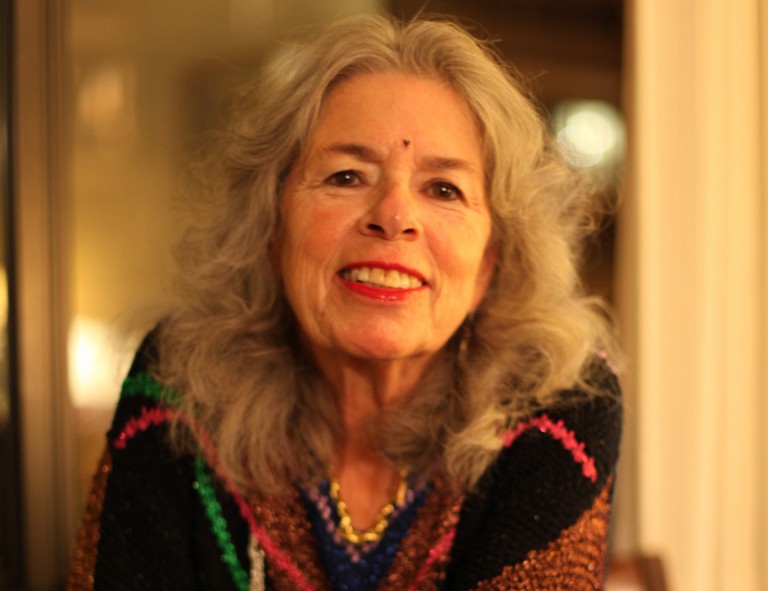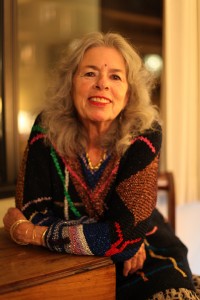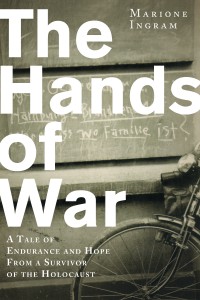Scrawled in white on a wall of his family’s bombed out apartment building pictured on the cover of Marione Ingram’s new
book, “The Hands of War: A Tale of Endurance and Hope from a Survivor of the Holocaust,” the German words ask a question that haunted millions of people inthe aftermath of World War II: “Wo familie ist?”
Where is my family?
It was Ingram’s father, Edward –a non-Jew German who had been active in the underground movement against the Nazis – who penned these words while searching for his wife, who was Jewish, and three daughters after being split from them during the war that ended with most of Ingram’s family being murdered.
After 18 months of hiding in an earthen dugout and small shed following escaping a firebombing of Hamburg, Germany that left tens of thousands of people dead and reduced their hometown trouble in 1943, Ingram, her mother, and two sisters found their way back to their father.
“My whole life is a result of that experience,” Ingram, who will speak about her recently published memoir at the Central Queens YM & YWHA on April 8, said of the war. “My thinking, my actions are all directly related to it. I’m immensely grateful to be alive. I’m extremely fortunate because I have the most wonderful human being I share my life with, and I have a son and two grandsons. I’ve come out of the ashes of a nearly totally destroyed family and have created my own.”
Ingram, 77, now an artist living in Washington D.C., will share her story at 1:30 p.m. at theCentral Queens YM & YWHA, which is located at 67-09 108th St. in Forest Hills.
The publication of her memoir, which details her life during the war, as well as her move to theUnited States – where she became a committed Civil Rights activist who worked at a FreedomSchool in Mississippi and organized a voter registration drive for African Americans – marks theculmination of decades of attempting to write about a childhood marred by nothing less than evil.
“I started writing about my experience of the war in Nazi Germany as a teenager in the 1950s, when I came to the United States,” Ingram said. “It wasn’t because I wanted to write a masterpiece – I wrote it out of a desperate need to allay the inner demons that still haunted me. I was experiencing what we now know as Post Traumatic Stress Disorder. I’d have terrible nightmares; I’d panic every time a fire alarm went off. I’d write to allay the demons, but it was much too painful.”
It wasn’t until 1957, when she was lying in bed with her husband, Daniel – who she met in the stairwell of a building on 14th Street in Manhattan – that she finally began to really process the memories of the war.
“I was able to recall the experience of running through the flaming streets of Hamburg with my mother,” she said. “After that night, I put most of what I had experienced on paper and gradually became less troubled by it.
”And so, after decades of working through the memories of a child caught in a genocide that killed more than six million Jews, Ingram published the book that she hopes will remind peoplethat war is not something that happens far away, on movie screens, to people one does not know.
War, as experienced by her and so many others around the globe, is unimaginable horror that rips apart families and leaves psychological scars in everyone who survives, she said.
“The generation of Holocaust survivors is not around much longer to tell their stories, and it’s up to subsequent generations to keep this story alive,” Ingram said. “I want people to take away from my book the idea that nonviolence is a better means of resolving conflict than killing.One of the things that compelled me to write the book is we seemed to not have learned such lessons.”
Born in 1935, Ingram grew up in Nazi Germany. The day before her sixth birthday, her grandmother was taken away and murdered in Minsk – a “death camp where people were stripped and made to kneel in front of their mass graves,” Ingram said.
Just prior to the Allied bombing of Hamburg – which was named Operation Gomorrah and killed an estimated 42,600 civilians – Ingram’s mother had received notice that she and her family were going to be deported to a death camp. Because Ingram and her sisters were presumed dead after the bombings, they were able to escape what she said would have almost inevitably been their deaths at the camp and spent the last 18 months of the war in hiding.
After the war ended, she and her family remained in Germany until 1952 – during which time she was constantly attacked, physically and mentally, for being Jewish.“After the war, I was in school in Hamburg and all of my teachers were Nazis,” Ingram said. “I had a daily experience of the ugliest sort where the teachers absolutely did not hesitate to referto me as sub-human, despite the fact that I was a very apt pupil. On my way to and from school,I’d be spat upon and often beaten. It was a traumatic experience, and it makes me realize how important it is that we speak out when we see somebody – somebody of a different religion, race, nationality – being maltreated.”
Peggy Kurtz, a librarian and coordinator for the Central Queens YM & YWHA spring series,“Conversations with Outstanding Authors and Filmmakers,” said she is thrilled Ingram is coming to speak at the organization.
“What makes Marione’s story so special, for me, is the way in which she has used her experience to help others throughout her lifetime,” Kurtz said. “Despite her own experience of living inmortal fear during the Holocaust, she chose, less than 20 years later, to risk her own life to fight for civil rights for others.”
Ingram’s talk is open to the public, and a $6 voluntary donation is requested. More information isavailable at www.cqy.org, by calling (718) 268-5011, ext. 151, or by emailing pkurtz@cqy.org.
By Anna Gustafson



